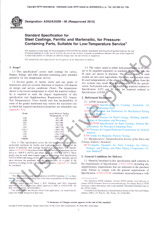We need your consent to use the individual data so that you can see information about your interests, among other things. Click "OK" to give your consent.
ASTM D8377-21a
Standard Guide for High Temperature Strength Measurements of Graphite Impregnated with Molten Salt (Includes all amendments and changes 7/21/2021).
Translate name
STANDARD published on 1.7.2021
The information about the standard:
Designation standards: ASTM D8377-21a
Publication date standards: 1.7.2021
SKU: NS-1030296
The number of pages: 5
Approximate weight : 15 g (0.03 lbs)
Country: American technical standard
Category: Technical standards ASTM
Annotation of standard text ASTM D8377-21a :
Keywords:
elevated temperature, graphite, molten salt, strength,
Additional information
| Significance and Use |
|
5.1?The Molten Salt Reactor is a nuclear reactor which uses graphite as reflector and structural material, and molten salt as coolant. The graphite components will be submerged in the molten salt during the lifetime of the reactor. The porous structure of graphite may lead to molten salt permeation, which can affect the thermal and mechanical properties of graphite. Consequently, it may be necessary to measure the various strengths of the manufactured graphite materials after impregnation with molten salt and before exposure to the reactor environment in a range of test configurations in order for designers or operators to assess their performance. Note 1:?Depending upon the salt selected for the reactor,
there may be some chemical reaction between the salt and the
graphite that could affect properties. The user should establish,
prior to following this guide, that any interactions between the
molten salt and graphite are understood and any implications for
the validity of the strength tests have been assessed.
5.2?For gas-cooled reactors, the strength of a graphite specimen is usually measured at room temperature. However, for molten salt reactors, the operating temperature of the reactor must be higher than the melting temperature of the salt, and so the salt will be in solid state at room temperature. Consequently, room temperature measurements may not be representative of the performance of the material at its true operating conditions. It is therefore necessary to measure the strength at an elevated temperature where the salt is in liquid form. Note 2:?Users should be aware that a small increase in
graphite strength is expected with increasing temperature. Testing
at the plant operating temperature will eliminate this small
uncertainty.
5.3?The purpose of this guide is to provide considerations, which should be included in testing graphite specimens impregnated with molten salt at elevated temperature. 5.4?For the test results to be meaningful, the test material must have been impregnated at the reactor operating temperature of interest and the strength measurement conducted at the same temperature following this guide. The user must consider the effect of interaction between graphite and impregnated salt on the representativeness of the strength test based upon the heating and cooling stages between impregnation and testing. Note 3:?The user may wish to measure the strength of the same
test geometry on unimpregnated graphite both at room temperature
and at the chosen elevated temperature as a benchmark prior to the
testing of the impregnated material.
Note 4:?The user may wish to demonstrate that the impregnated
test specimen does not lose molten salt during the elevated
strength test procedure. This should be performed by putting the
impregnated specimen through the exact procedure (temperature and
duration) without applying any test load, weighing the specimen
before and after the procedure. A reduction in mass will indicate
loss of molten salt and the user will then need to assess its
significance.
|
| 1. Scope |
|
1.1 This guide covers the best practice for strength measurements at elevated temperature of graphite impregnated with molten salt. 1.2?The values stated in SI units are to be regarded as standard. No other units of measurement are included in this standard. 1.3?This standard does not purport to address all of the safety concerns, if any, associated with its use. It is the responsibility of the user of this standard to establish appropriate safety, health, and environmental practices and determine the applicability of regulatory limitations prior to use. 1.4?This international standard was developed in accordance with internationally recognized principles on standardization established in the Decision on Principles for the Development of International Standards, Guides and Recommendations issued by the World Trade Organization Technical Barriers to Trade (TBT) Committee. |
We recommend:
Technical standards updating
Do you want to make sure you use only the valid technical standards?
We can offer you a solution which will provide you a monthly overview concerning the updating of standards which you use.
Would you like to know more? Look at this page.




 Cookies
Cookies
